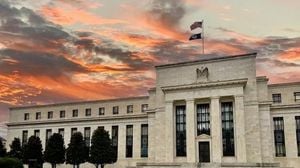Blue Owl Capital is drawing fresh attention from institutional investors and Wall Street analysts alike, as the company’s recent earnings, dividend announcements, and expanding role in the alternative assets space signal a pivotal moment for the business development firm. With a series of significant investments and strategic moves unfolding in 2025, Blue Owl Capital finds itself at the intersection of shifting market dynamics, regulatory changes, and evolving investor appetites.
In the first quarter of 2025, Mackenzie Financial Corp made headlines by purchasing 35,802 shares of Blue Owl Capital Corporation, valued at approximately $525,000, according to the company’s latest SEC filing. This move was just one among several by major institutional investors, underscoring a growing confidence in Blue Owl’s long-term prospects. Oregon Public Employees Retirement Fund, for instance, increased its stake in Blue Owl Capital by a staggering 222% during the same period, now holding 16,098,695 shares worth $236,007,000 after acquiring an additional 11,098,695 shares. Not to be outdone, Cresset Asset Management LLC ramped up its stake by an eye-popping 8,188.9% in the fourth quarter of 2024, now owning 4,439,547 shares worth $68,762,000 after purchasing 4,385,987 shares. Trustees of Dartmouth College and Raymond James Financial Inc. also entered the fray with new positions valued at $48,774,000 and $28,434,000 respectively, while HB Wealth Management LLC boosted its stake by 311.3%, now holding 1,131,920 shares worth $16,594,000. According to figures compiled by MarketBeat, institutional investors collectively own 42.83% of Blue Owl Capital’s stock, highlighting the company’s growing appeal among large-scale players.
Blue Owl Capital’s performance metrics have only added to this momentum. On August 6, 2025, the company reported quarterly earnings per share (EPS) of $0.40, edging out the consensus estimate of $0.39. Revenue for the quarter reached $485.84 million, surpassing analyst expectations of $480.42 million. The company’s net margin stands at 38.29%, with a return on equity of 11.24%—numbers that have not gone unnoticed on Wall Street. The stock itself traded up $0.16 during mid-day trading on Tuesday, hitting $14.25, with a market capitalization of $7.28 billion. Its price-to-earnings ratio sits at 9.44, and the company carries a beta of 0.74, reflecting relatively moderate volatility compared to the broader market. The stock’s one-year low and high are $12.11 and $15.73, respectively, and it maintains a debt-to-equity ratio of 1.20, alongside a quick and current ratio of 0.80 each. The fifty-day moving average price is $14.54, which also matches its 200-day moving average, suggesting a period of relative price stability.
Blue Owl Capital’s dividend strategy is another focal point for investors. The company recently announced a quarterly dividend of $0.37 per share, to be paid on October 15, 2025, to shareholders of record as of September 30, 2025. This represents an annualized dividend of $1.48, translating to a yield of 10.4%. The payout ratio stands at 98.01%, indicating that the company is distributing nearly all of its earnings to shareholders—a move often favored by income-focused investors. Meanwhile, Blue Owl Capital Inc Class A (Symbol: OWL) will also trade ex-dividend on August 14, 2025, for its upcoming quarterly dividend of $0.225 per share, payable on August 28, 2025. The estimated annualized dividend yield for this class is approximately 4.56%, according to Dividend Channel. On August 12, 2025, OWL shares traded flat, reflecting a wait-and-see approach among traders ahead of the ex-dividend date.
Insider activity has added another layer of intrigue. Director Victor Woolridge acquired 6,915 shares on May 27, 2025, at an average cost of $14.45 per share, representing a 32.50% increase in his holdings. Following this transaction, Woolridge now owns 28,191 shares, valued at approximately $407,359.95. Such insider purchases are often interpreted by the market as a vote of confidence in the company’s future prospects, particularly when they come from board members with deep insight into the firm’s operations.
Wall Street analysts have been quick to weigh in on Blue Owl Capital’s outlook. Wells Fargo & Company recently cut its target price from $15.00 to $14.00, maintaining an “equal weight” rating, while B. Riley initiated coverage with a “buy” rating and a $15.00 target price. LADENBURG THALM/SH SH upgraded the stock to a “strong-buy” rating, and Royal Bank Of Canada reiterated an “outperform” rating with a $16.00 target price. According to MarketBeat, the consensus among analysts is a “Buy” rating, with an average target price of $15.42. Of the analysts surveyed, two rated the stock as a hold, three as a buy, and four as a strong buy, reflecting a generally optimistic sentiment about Blue Owl Capital’s growth trajectory.
Behind these numbers and ratings lies a broader story about the shifting landscape of alternative assets. As of August 12, 2025, institutional investors are fueling a boom in the secondaries markets for alternative assets such as private equity, real estate, and cryptocurrencies. According to recent reports, policymakers in Washington are actively laying the groundwork to facilitate broader access to these alternatives within 401(k) plans—a move that could further expand the investor base for firms like Blue Owl Capital. The company itself specializes in direct and fund of fund investments, targeting senior secured, direct lending or unsecured loans, subordinated loans, mezzanine loans, and a variety of equity-related securities, including warrants and preferred stocks. Blue Owl Capital also pursues preferred equity investments, first lien, unitranche, and second lien term loans, as well as common equity investments, placing it squarely at the heart of the alternative asset boom.
For investors, the key questions now revolve around Blue Owl Capital’s ability to sustain its earnings momentum, maintain its generous dividend policy, and capitalize on the expanding universe of alternative investments. The company’s robust institutional support, strong analyst endorsements, and strategic positioning in a rapidly evolving market suggest it is well poised to navigate the challenges and opportunities ahead. As the regulatory environment shifts and investor preferences continue to evolve, all eyes will be on Blue Owl Capital to see if it can deliver on its promise and maintain its upward trajectory in the months to come.
With institutional money pouring in, dividends holding strong, and Washington’s policy gears turning, Blue Owl Capital stands at a crossroads—ready to shape, and be shaped by, the next chapter in alternative asset investing.




